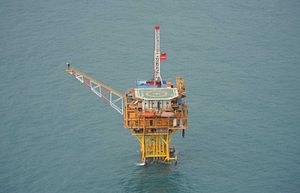The China-Japan dispute in the East China Sea is back in the spotlight this week. Japanese Foreign Minister Fumio Kishida lodged a protest with the Chinese embassy on June 2 for new construction at two Chinese gas facilities. The Ministry had just confirmed that China was constructing drilling towers in the East China Sea near the median line Japan has proposed as a demarcation line. The construction was spotted by Self-Defense Forces personnel flying over the area in late May.
Kishida told reporters, “It is extremely regrettable that China is proceeding with unilateral developments in the East China Sea even though the boundary between Japan and China in the waters has not yet been fixed.” Kishida, again, asked China to return to talks on a 2008 bilateral accord.
Back in 2008, both sides had agreed to cooperate on natural resources development, but Japan has since backtracked, wanting to postpone the project until both sides’ Economic Exclusive Zones (EEZs) were demarcated. Japanese and Chinese leaders had agreed to try to restart stalled negotiations on the topic when they met last November.
Kishida’s publicization of Chinese construction activities is likely a continuation of Japanese efforts to remind the world about their dispute with China, even as the East China Sea dispute, centered on the Senkaku/Dioayu Islands, increasingly takes a back seat to the South China Sea disputes.
In Japan’s most recent Defense White Paper, released last July, the Japanese Ministry of Defense expressed concern about the offshore gas platforms that China had been constructing in the disputed waters of the East China Sea since June 2013.
Japan wants China to halt its unilateral project, which is on China’s side of Japan’s proposed median line – the geographical equidistance line – because China could inadvertently siphon Japanese undersea resources, due to sheer proximity to the proposed demarcation. The paper explains, “Our country has repeatedly lodged protests with China’s unilateral development and urged it to stop the construction work.” However, China has pressed on contrary to Japanese wishes.
Last July, the Japanese Ministry of Foreign Affairs jumped into the game when they released to the public maps and photographs of 16 Chinese marine platforms close to the proposed median line. According to Chief Cabinet Secretary Yoshihide Suga, 12 new structures were confirmed since June 2013. The Ministry of Foreign Affairs urged China to return to negotiations on the 2008 deal as soon as possible.
Last summer, when MOFA released its visual data, The Diplomat’s Shannon Tiezzi noted that it was likely a Japanese attempt to “redirect international criticisms of China’s actions in the South China Sea by following the Philippines’ example and making photographs and other evidence publicly available.”
Even though Japanese Prime Minister Shinzo Abe played a key role in raising questions about China’s activities in the South China Sea at the G7 summit held in Japan last week, Japan also doesn’t want the world to forget about the East China Sea. And, as the world – much like any individual – has a limited attention span, the more broadband the South China Sea disputes take up, the less attention will be paid to the East China Sea dispute.
Japan does have an indirect interest in the South China Sea, but what really matters to Tokyo directly is the East China Sea, where it has its own dispute with China.

































